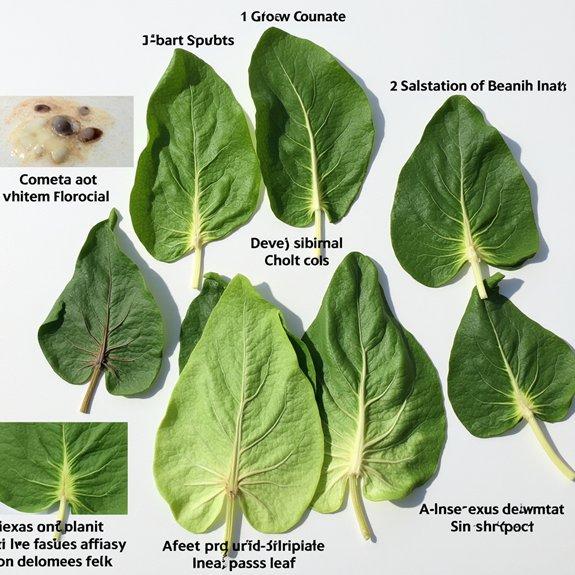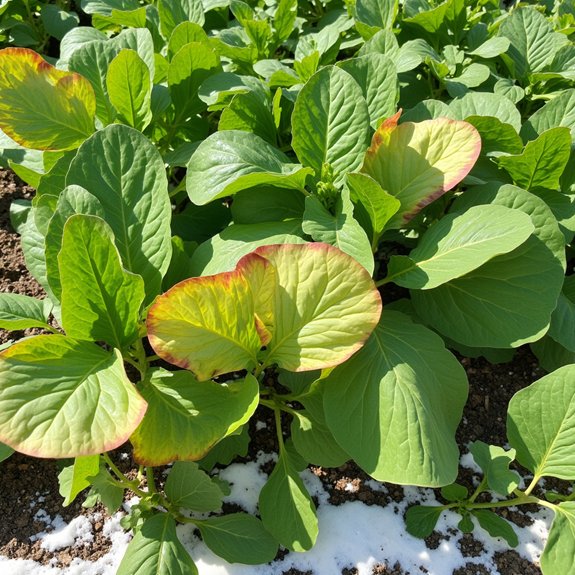Spinach leaves displaying white patches or yellow discoloration often signal specific problems that gardeners can identify and fix. These color changes typically stem from nutrient imbalances, watering mistakes, or fungal infections that attack the plant’s cellular structure. The most common culprits include nitrogen deficiency causing yellowing, downy mildew creating white spots, and overwatering leading to root damage. Understanding which factor affects your plants determines the exact solution needed.
Contents
- 1 Common Causes of Spinach Leaf Discoloration
- 2 Nutrient Deficiencies Leading to Yellow Leaves
- 3 Overfertilization and Its Impact on Leaf Health
- 4 Soil Ph and Watering Issues Affecting Spinach
- 5 Root Rot From Poor Drainage
- 6 Blight and Downy Mildew Infections
- 7 White Rust Disease in Spinach Plants
- 8 Prevention Strategies for Healthy Spinach Growth
Common Causes of Spinach Leaf Discoloration

When spinach leaves begin changing color, several underlying issues could be at play, ranging from simple nutrient deficiencies to serious fungal diseases. Yellow leaves often signal treatable problems like nitrogen shortage or improper watering, while white discoloration typically indicates more serious concerns.
Environmental stress plays a major role in leaf discoloration. Factors like incorrect soil pH, overwatering, or temperature fluctuations weaken plants considerably. Poor pest management allows aphids and thrips to spread diseases like blight, accelerating color changes.
Natural aging causes outer leaves to yellow first, but widespread discoloration throughout young plants suggests underlying health issues requiring immediate attention.
Nutrient Deficiencies Leading to Yellow Leaves
Although yellow spinach leaves often alarm gardeners, nitrogen deficiency ranks as the most common and treatable culprit behind this discoloration. Nitrogen fuels chlorophyll production, keeping leaves vibrant green. Without adequate nitrogen, older leaves yellow first as plants redirect nutrients to new growth.
Boron deficiency also causes yellowing, though less frequently. Poor nutrient absorption stems from incorrect soil pH, typically above 7.0. Test soil pH monthly during growing season.
Quality spinach care includes applying balanced fertilizer every three weeks. Choose 10-10-10 fertilizer, following package directions precisely. Soil testing reveals specific deficiencies, enabling targeted treatment rather than guesswork.
Overfertilization and Its Impact on Leaf Health

While providing adequate nutrition prevents deficiency-related yellowing, excessive fertilizer application creates equally damaging problems for spinach plants. Overfertilization causes fertilizer toxicity, leading to salt buildup in soil that damages delicate root systems. This creates leaf burn, appearing as yellowing followed by brown spots and crispy edges.
Excessive nutrients stress plants just as much as deficiencies do. Symptoms include wilting, uneven discoloration, and stunted growth despite abundant feeding. The damaged roots cannot properly transport water and nutrients.
Flush overfertilized soil with clean water to reduce salt concentrations. Prevention involves following package directions exactly and testing soil regularly.
Soil Ph and Watering Issues Affecting Spinach
Beyond nutrient management, soil pH creates the foundation for healthy spinach growth by controlling how effectively plants can access available nutrients. Spinach thrives in slightly acidic conditions around 6.5 pH, where essential minerals remain readily available. When soil composition becomes too alkaline, leaves begin yellowing despite adequate fertilization.
Watering frequency directly impacts nutrient uptake and overall plant health. Underwatered spinach develops stress symptoms, starting with wilting followed by yellowing leaves. However, overwatering creates waterlogged conditions that suffocate roots, leading to rot and similar discoloration. Check soil moisture regularly, maintaining consistent hydration without creating soggy conditions that invite fungal problems.
Root Rot From Poor Drainage

Saturated soil conditions suffocate spinach roots, preventing them from absorbing the oxygen necessary for cellular respiration and nutrient transport. When waterlogged soil persists for 24-48 hours, fungal pathogens attack weakened roots, turning them brown and mushy. This fungal invasion makes proper root care nearly impossible once established.
Effective drainage solutions include adding perlite or coarse sand to heavy clay soils, creating raised beds 6-8 inches high, or installing French drains around planting areas. Check soil moisture by inserting your finger 2 inches deep—it should feel damp but not soggy. Prevention beats treatment every time with root rot.
Blight and Downy Mildew Infections
Root problems aren’t the only threat to healthy spinach plants, as fungal and viral diseases can quickly turn vibrant green leaves into yellow, spotted messes. Blight, caused by Cucumber Mosaic Virus, spreads through aphids and thrips, creating distinctive blight symptoms like yellow spots around leaf veins and stunted growth.
Downy mildew attacks seedlings and mature plants alike, producing yellow patches that expand into tan areas. Purple fungus often appears on leaf undersides, causing distortion and inward curling.
Effective mildew treatment requires removing infected plants immediately, improving air circulation, and avoiding overhead watering that increases humidity levels around vulnerable foliage.
White Rust Disease in Spinach Plants
When spinach leaves transform from their characteristic green to an alarming white color, white rust disease is almost certainly the culprit. This fungal infection, caused by Albugo occidentalis, starts subtly with small yellow spots that gradually expand across leaf surfaces.
The telltale sign appears on leaf undersides: distinctive white blisters that separate white rust from similar diseases like downy mildew. As the infection progresses, entire leaves bleach white, becoming completely unusable.
Effective disease management requires immediate removal and destruction of infected plants. Prevention focuses on proper spacing for air circulation, avoiding overhead watering, and maintaining ideal growing conditions to strengthen plant immunity.
Prevention Strategies for Healthy Spinach Growth
While treating diseased spinach plants proves challenging, implementing proper prevention strategies from the start creates robust plants that naturally resist common problems. Plant rotation prevents soil-borne pathogens from establishing permanent residence in your garden beds. Move spinach to different locations each season, waiting at least two years before replanting in the same spot.
Effective pest management involves regular monitoring for aphids and thrips that spread viral diseases. Install row covers during vulnerable growth periods, maintain proper spacing for air circulation, and remove garden debris promptly. Consistent watering schedules, balanced fertilization, and soil pH maintenance around 6.5 create ideal growing conditions that strengthen natural plant defenses.
